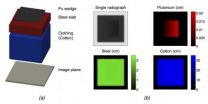(Press-News.org) ITHACA, N.Y. – If an insect drew a line as it chased its next meal, the resulting pattern would be a tangled mess. But there's method to that mess, says Jane Wang, a Cornell University professor of mechanical engineering and physics, who tries to find simple physical explanations for complex, hardwired animal behaviors.
Photo: https://cornell.box.com/tbeetle
It turns out the tiger beetle, known for its speed and agility, does an optimal reorientation dance as it chases its prey at blinding speeds. Publishing online April 9 in the Journal of the Royal Society Interface, Wang and colleagues used high-speed cameras and statistical analysis to reveal a proportional control law in which the angular position of prey, relative to the beetle's body axis, drives the beetle's angular velocity with a delay of 28 milliseconds. That's about a half-stride in beetle terms.
These observations led Wang to propose a physical interpretation of the behavior: that to turn toward its prey, the beetle, on average, exerts a sideways force proportional to the prey's angular position, measured a half-stride earlier.
"The idea is to find laws that animals use to intercept their prey," Wang said. "We do it, too [interception] – when trying to catch a baseball, or when chasing someone. But since insects have a smaller number of neurons, their behaviors are more likely hardwired, which makes it possible for us to find and understand the rules they follow."
Why the tiger beetle? It's a nice model system, Wang said, which she learned after attending a talk several years ago by Cornell entomology professor Cole Gilbert, who studies neural mechanisms of behavior in arthropods and is a paper co-author. Andreas Haselsteiner, the paper's first author, was a visiting student in Wang's lab and designed the experiments.
For the experiments, a "dummy prey" – a black bead – was dangled in front of the beetle, which, mistaking the bead for a meal, would give chase. Its chasing patterns were recorded with a high-speed camera.
From their analysis emerged a macroscopic description of the animal's movements, which reveals an internal time scale that governs the beetle's sensing-to-actuation system and a close-to-optimal gain value in the control algorithm, Wang said.
From an evolutionary point of view, the sensing and moving are intimately connected, Wang continued. Some of the hundreds of thousands of neurons that function for sight are directly connected to the machinery for locomotion, which is directly related to the animal's instinct to survive – that is, eat. Thus, studying how animals move can provide insight into how they sense their environment, and vice versa, she said.
INFORMATION:
Cornell University has television, ISDN and dedicated Skype/Google+ Hangout studios available for media interviews. For additional information, see this Cornell Chronicle story.
Photo: Tiger beetle's chase highlights mechanical law
2014-04-15
ELSE PRESS RELEASES FROM THIS DATE:
Researchers transplant regenerated esophagus
2014-04-15
Tissue engineering has been used to construct natural oesophagi, which in combination with bone marrow stem cells have been safely and effectively transplanted in rats. The study, published in Nature Communications, shows that the transplanted organs remain patent and display regeneration of nerves, muscles, epithelial cells and blood vessels.
The new method has been developed by researchers at Karolinska Institutet in Sweden, within an international collaboration lead by Professor Paolo Macchiarini. The technique to grow human tissues and organs, so called tissue engineering, ...
Sensitive detection method may help impede illicit nuclear trafficking
2014-04-15
WASHINGTON D.C., April 15, 2014 -- According to the International Atomic Energy Agency (IAEA) the greatest danger to nuclear security comes from terrorists acquiring sufficient quantities of plutonium or highly enriched uranium (HEU) to construct a crude nuclear explosive device. The IAEA also notes that most cases of illicit nuclear trafficking have involved gram-level quantities, which can be challenging to detect with most inspection methods.
According to a new study appearing this week in the Journal of Applied Physics, coupling commercially available spectral X-ray ...
New study from Harvard identifies transgender health disparities
2014-04-15
New Rochelle, NY, April 15, 2014—Transgender individuals are medically underserved and their healthcare needs incompletely understood in part because they represent a subpopulation whose health is rarely monitored by U.S. national surveillance systems. To address these issues, a new study compared methods of collecting and analyzing data to assess health disparities in a clinical sample of transgender individuals, as reported in an article published in LGBT Health, a peer-reviewed journal from Mary Ann Liebert, Inc., publishers. The article is available free on the LGBT ...
Targeting cancer with a triple threat
2014-04-15
CAMBRIDGE, MA -- Delivering chemotherapy drugs in nanoparticle form could help reduce side effects by targeting the drugs directly to the tumors. In recent years, scientists have developed nanoparticles that deliver one or two chemotherapy drugs, but it has been difficult to design particles that can carry any more than that in a precise ratio.
Now MIT chemists have devised a new way to build such nanoparticles, making it much easier to include three or more different drugs. In a paper published in the Journal of the American Chemical Society, the researchers showed ...
Online reviews: When do negative opinions boost sales?
2014-04-15
When purchasing items online, reading customer reviews is a convenient way to get a real-world account of other people's opinions of the product. According to a new study in the Journal of Consumer Research, negative reviews that are offset by a politeness-factor can actually help sell the item.
"Most of the research on consumer reviews has been on the content and volume of the message," write authors Ryan Hamilton (Emory University), Kathleen D. Vohs (University of Minnesota), and Ann L. McGill (University of Chicago Booth School of Business). "Our research looks at ...
Hair from infants gives clues about their life in the womb
2014-04-15
MADISON – Like rings of a tree, hair can reveal a lot of information about the past.
It can tell if a person recently used drugs or an athlete was doping. It can provide information about hormones and expose environmental toxins.
And, as a team of University of Wisconsin-Madison researchers show in a study of rhesus monkeys, published in the April 2014 edition of the journal Pediatric Research, it can also reveal the womb environment in which an infant formed.
It's the first time researchers have used infant hair to examine the hormonal environment to which the fetus ...
Unexpected protein partnership has implications for cancer treatment
2014-04-15
Scientists have identified two unlikely partners, in a type of immune cell called a macrophage, that work together, in response to cancer drugs, to increase inflammation in a way that may alter tumor growth. Researchers from the National Institutes of Health published the study in the journal Cancer Research.
These partners are the p53 protein that suppresses tumors and the nuclear factor-kappaB (NF-kappaB) protein that stimulates their growth. Blocking this partnership could help prevent inflammation from occurring in cancer patients undergoing chemotherapy.
"Since ...
New method of screening children for autism spectrum disorders works at 9 months old
2014-04-15
Washington, DC – Researchers, including a team from Children's National Health System, have identified head circumference and head tilting reflex as two reliable biomarkers in the identification of autism spectrum disorders (ASD) in children that are between 9 and 12 months of age.
According to the U.S. Centers for Disease Control and Prevention, ASD is identifiable as early as two years old, although most children are not identified until after the age of four. While a number of studies have reported that parents of children with ASD notice developmental problems in ...
Low-calorie restaurant menus: Are they making us fat?
2014-04-15
Depending on our food cravings, the number of items served, and even the time of day, ordering a meal at a restaurant often requires a "narrowing down" decision making process. According to a new study in the Journal of Consumer Research, restaurants that now provide "low-calorie" labels on their menus can inadvertently cause people to eliminate healthy foods right off the bat.
"Because most restaurant menus are quite complex—offering numerous dishes composed of multiple ingredients—diners try to simplify their decision. People have come to expect low-calorie food to ...
More should be done for female parolees
2014-04-15
EAST LANSING, Mich. --- As the female prison population grows, a new study funded partly by the National Science Foundation says more should be done to help women probationers and parolees in poor urban areas remain crime-free.
A team of Michigan State University criminologists found black women on probation and parole feel they have little choice but to isolate themselves in their homes or risk getting caught up in the type of criminal activity that got them in trouble in the first place.
Probation and parole officers, case managers and others should help the women ...



